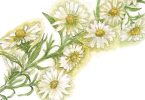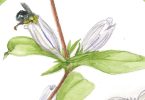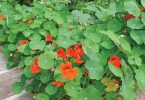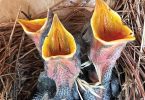
My pond in spring. Photo by Judith Canty Graves
By Judith Canty Graves
Spring is a long and glorious season in the southern Appalachian mountains. It can begin as early as late February, but gets fully under way in early March despite occasional cold and snowy days. The earth is soft, the birds begin to sing and this is the time I plant my pea seeds. While nighttime temperatures in early March can be just below freezing, daytime temperatures are usually mild. The peas don’t seem to mind.
In March, the landscape is still mostly bare and brown, but color is creeping onto the trees and on the ground—in fact everywhere.
Most people are aware of daffodils in the spring, but there is more to see for the observant gardener. By mid-March, the peas are germinating and poking tiny green heads above the soil. Burgundy tips of peonies also start appearing. Looking closely, I can see small green catnip shoots near the circular leaves of my autumn sedum. The Knock Out rose bushes are unfurling dark red leaves.
By the third week of March, many flowering trees are coming to life, such as the Bradford Pear, Weeping Cherry and Star Magnolia. Their glorious blooms last about two weeks, then fade and are replaced by green leaves. Robins appear with joyful birdsong every morning as the birds call to each other.
With April comes a burst of colorful growth, green lawns and leaves on trees. By mid-April the Appalachian Redbud is the most vivid flowering tree with its tiny pink blooms. Dogwoods and cherry trees put forth white and pink blossoms. The daffodils are fading, but at that point, colorful phlox covers the ground with tones of vivid pink and lavender. As soon as some plants finish, others begin in a succession of vibrant color, such as the azaleas that begin blooming in April and continue into May.
April also heralds the return of many different types of insects. One notable and visible insect is the swallowtail butterfly. This is the month that bees begin their season of pollinating flowers.
May brings accelerated growth and blooms with a nonstop display of beauty. In my yard, the climbing clematis, the Siberian and bearded irises, and exquisite peonies take center stage, while the hydrangeas begin to show their blue, pink and white flowers.
In Asheville, spring extends into June. I can tell because my peas are still hanging on. Early June is when fireflies begin to appear and the Oakleaf hydrangeas begin to bloom. Tiny praying mantises walk around after hatching. The earth is now fully alive with plants, insects and birds. By mid-June the summer heat begins, putting an end to a long and exciting spring season.
Judith Canty Graves is a home gardener with a background in photojournalism. She lives in Asheville. To see more of her garden photography, visit TheObservantGardener.com.







Please don’t celebrate the blooms of non-native invasives like Bradford pear! They should be destroyed, not honored. Native plants are desperately needed for our threatened biodiversity, not ornamentals.
Dear Janet, You are correct about the Bradford Pear trees being invasive and they should be replaced with native plants. I agree. Unfortunately, many of these trees have already been planted. I was simply observing their spring flowers in my column, not endorsing that homeowners plant them.
I am planning a future column on planting more appropriate plants for our environments. There is an excellent list of native plants for the Southeast on The Pollinator Victory Garden website at https://www.ecobeneficial.com/pvg/pollinator-plants-for-the-southeast-and-east-south-central-region/. I will certainly refer to it this spring when selecting new plants for my property. The Pollinator Victory Garden book is outstanding! I hope many gardeners will study it. Thanks for your comment.
Judith Canty Graves